The Ultimate Guide to Oracle Forms Modernization
The Ultimate Guide to Oracle Forms Modernization
Legacy Oracle Forms applications are becoming a liability in today’s cloud-native, API-first world. In this ultimate guide, discover how RENAPS' ORMIT™-OpenJava delivers a fully automated, vendor-agnostic modernization path—preserving 99% of business logic while transforming Forms into scalable, maintainable React or Angular applications. Packed with industry insights, architectural comparisons, and real customer success stories, this comprehensive resource shows why organizations worldwide trust RENAPS to future-proof their mission-critical systems. Whether you're navigating high TCO, talent shortages, or integration hurdles—modernization starts here.
Titleimage
Posted by Sandra Hamou on 2025:05:14 17:17:04
THE ULTIMATE GUIDE TO ORACLE FORMS MODERNIZATION
Organizations running Oracle Forms face a critical decision: maintain aging systems at escalating costs or modernize to unlock agility, scalability, and innovation. Oracle Forms, a cornerstone of enterprise applications for decades, now poses strategic challenges—rising costs, talent shortages, and architectural limitations that hinder modern IT demands.
At RENAPS, we’ve spent over a decade helping organizations worldwide transform their Oracle Forms applications into future-ready, cloud-native solutions. Our ORMIT™-OpenJava platform delivers unmatched automation, preserving business logic while empowering teams with modern, maintainable architectures. This guide is the most comprehensive resource available for Oracle Forms Modernization, offering actionable insights, technical details, and strategic guidance to help you navigate this critical transition with confidence.
Whether you’re an IT leader, developer, or business stakeholder, this article will equip you with everything you need to modernize Oracle Forms effectively—and why RENAPS is your trusted partner in this journey.
Why Oracle Forms Modernization Matters Now
Oracle Forms has powered mission-critical applications since the late 1970s, evolving from character-based interfaces to web deployments. Yet, its core architecture remains rooted in client-server paradigms, struggling to meet today’s cloud-native, mobile-first, and API-driven requirements. Delaying modernization risks escalating costs, security vulnerabilities, and missed opportunities for innovation.
The Evolution and Limitations of Oracle Forms
Oracle Forms’ journey reflects its resilience but also its growing obsolescence. Here’s a snapshot of its evolution:
| VERSION NAME | RELEASE YEAR | KEY FEATURES AND NOTES |
|---|---|---|
| IAF (Interactive Application Facility) | 1979 | Initial release; character-based interface; comprised of IAG (compiler) and IAP (runtime interpreter)
|
| FastForms | 1982 |
Introduced with Oracle Database version 4; added form generation and editing tools |
| SQL*Forms 2.0 | 1985 |
Enhanced procedural capabilities; served as the foundation for Oracle Financials |
| Oracle Forms 3.0 | 1986 |
First to support PL/SQL; improved IDE; character mode with GUI window support |
| Oracle Forms 4.0 | 1988 | First true GUI-based version; introduced new IDE with object-specific editors |
| Oracle Forms 4.5 | 1992 | Major IDE overhaul; introduced object navigator and property sheets; aligned with Visual Basic standards |
| Oracle Forms 5.0 | 1995 | Accompanied Oracle Database version 7; enhanced GUI features |
| Oracle Forms 6.0 / 6i | 1998 | Introduced Forms Server for web deployment; maintained client-server support |
| Oracle Forms 9i | 2001 | Web-based deployment only; removed client-server runtime; enhanced Java integration |
| Oracle Forms 10g | 2003 | Rebranded Forms 9.0.4; aligned with Oracle Database 10g; improved web deployment |
| Oracle Forms 11g | 2009 |
Introduced external events, JavaScript integration, and performance monitoring tools |
| Oracle Forms 12c |
2015 |
Added Java Web Start support; enhanced REST integration; improved UI components |
| Oracle Forms 14.1.2.0 | 2024 |
Latest release; modernized widgets; native REST data source support |
Despite updates like REST integration in Oracle Forms 14c, the platform remains monolithic, stateful, and tied to Oracle WebLogic. It lacks support for mobile-first design, microservices, or modern DevOps pipelines, making it a strategic liability for organizations aiming to innovate.
Industry Pain Points Driving Modernization
The urgency to modernize stems from several critical challenges:
- Shrinking Talent Pool: Oracle Forms expertise is vanishing. Most developers are nearing retirement, and younger professionals favor modern technologies. Fewer than 10% of organizations have access to Forms developers under 45 (Source: “The Quest for the Last Oracle Forms Developer”).
- Outdated Architecture: Oracle Forms’ client-server roots limit integration with REST APIs, microservices, and cloud-native systems, stifling innovation.
- Rising Costs: High licensing fees for Oracle middleware, aging infrastructure, and specialized talent inflate total cost of ownership (TCO).
- Poor User Experience: Forms’ dated interfaces fail to meet modern expectations, reducing productivity and user satisfaction.
- Integration Challenges: Connecting Forms to API-first ecosystems requires costly workarounds, increasing technical debt.
Industry Insights Reinforcing the Need to Act
Leading analysts underscore the modernization imperative:
- Gartner: “By 2025, 90% of current applications will still be in use—but most will receive insufficient modernization investment.” By 2027, over 70% of enterprises will accelerate legacy modernization.
- Forrester: Modernization delivers 30–50% faster delivery times and lower operational costs.
- IDC: Technical debt from legacy systems costs enterprises over $1.2 million annually in lost productivity and delayed innovation.
- McKinsey: Successful modernization unlocks 10–20% incremental revenue growth through faster product launches and better customer experiences.
Modernizing Oracle Forms isn’t just a technical upgrade—it’s a strategic move to future-proof your business, reduce costs, and empower innovation.
Why Choose RENAPS and ORMIT™-OpenJava?
RENAPS’ ORMIT™-OpenJava is the industry-leading solution for Oracle Forms Modernization, offering a fully automated platform that transforms legacy applications into scalable, web-based solutions. Unlike other tools, ORMIT™-OpenJava preserves 100% of business logic, supports flexible architectures (Java + Node.js or Node.js-only, React or Angular), and eliminates vendor lock-in.
What is ORMIT™-OpenJava?
ORMIT™-OpenJava is a comprehensive modernization platform that automates the conversion of Oracle Forms into modern JavaScript or TypeScript applications. It maps Forms components—triggers, built-ins, data blocks, and PLL libraries—into maintainable, cloud-ready architectures using Redux, REST APIs, and React or Angular. Key features include:
- Automation-Driven: Achieves 88% overall automation, reducing manual effort and risks.
- Flexible Backends: Choose Java + Node.js or Node.js-only to align with your team’s expertise.
- Preserved Logic: Ensures business continuity by retaining core logic in JavaScript/TypeScript.
- Cloud-Ready: Deploys seamlessly on AWS, Azure, Google Cloud, or Oracle Cloud.
Why Analysis is the First Step
Successful modernization starts with understanding your Forms environment. ORMIT™-Analyzer provides a detailed assessment, scanning FMB, MMB, OLB, PLL, and RDF files to:
- Map module complexity and interdependencies.
- Identify dead code and optimization opportunities.
- Estimate time, cost, and effort for migration.
- Create a clear, risk-free roadmap.
This analysis ensures no surprises, empowering informed decisions and predictable outcomes.
Why Oracle Forms is “Sticky”
Oracle Forms’ richness—40+ item types, 150+ triggers, 500+ built-ins—makes it powerful but complex to migrate. Its event-driven, stateful design supports desktop-like applications that low-code platforms like Oracle APEX struggle to replicate. ORMIT™-OpenJava addresses this by:
- Preserving logic through custom event handling.
- Rebuilding UIs with component-based React or Angular.
- Ensuring scalability and maintainability without vendor lock-in.
Why Oracle APEX Falls Short
Oracle APEX is sometimes considered for Forms modernization, but it’s a poor fit for complex Forms applications due to:
- Functional Mismatch: APEX’s declarative nature can’t replicate Oracle Forms’ 220 built-ins, 97 triggers, or 473 properties, requiring extensive redesign.
- Vendor Lock-In: APEX ties you to Oracle Database, limiting database flexibility and increasing costs.
- Limited Scalability: APEX lacks the architectural flexibility for microservices or cloud-native deployments.
ORMIT™-OpenJava, paired with PostgreSQL via ORMIT™-Cortex, offers true freedom—preserving logic, enabling database independence, and supporting any cloud provider.
Emerging Trends in Legacy Modernization
The modernization landscape is evolving rapidly, driven by AI, flexible architectures, and cloud-native priorities. ORMIT™-OpenJava leverages AI for secure, line-by-line code conversion, ensuring business logic remains protected while accelerating migration. Unlike low-code platforms like Oracle APEX or OutSystems, which often introduce vendor lock-in, ORMIT™’s custom JavaScript/React stack offers unmatched flexibility and scalability. This aligns with Gartner’s 2025 trends emphasizing cloud-native enablement, empowering enterprises to build future-ready systems. While low-code platforms promise speed, ORMIT™-OpenJava’s custom stack ensures long-term scalability and freedom—perfect for complex enterprise needs. Learn more about ORMIT™’s architecture below.
Why ORMIT™ Outshines Alternatives
Unlike Oracle APEX, which locks you into Oracle’s ecosystem, ORMIT™-OpenJava delivers open-source flexibility with React/Angular frontends and Node.js or Java backends. This aligns with industry trends—79% of IT leaders prioritize open source for strategic flexibility.
Cloud Enablement and Platform Independence
ORMIT™-OpenJava delivers platform-agnostic applications, freeing you from Oracle Forms runtime, WebLogic, or proprietary IDEs. The resulting stack—built on JavaScript, TypeScript, Node.js, React, or Angular—integrates with modern DevOps pipelines and cloud platforms like:
- Oracle Cloud
- AWS
- Azure
- Google Cloud
- Private Kubernetes clusters
Key benefits include:
- No Lock-In: Full control over open-source code.
- Cloud-Native: Supports Docker, Kubernetes, and microservices.
- Scalability: REST-native architecture enables elastic scaling.
Technical Deep Dive: ORMIT™-OpenJava Architecture
ORMIT™-OpenJava offers two backend options to suit your stack:
- Java + Node.js: Combines Spring Boot APIs with Node.js for Forms compatibility, ideal for Java-centric teams.
- Node.js-Only: A lightweight, JavaScript/TypeScript stack for unified development.
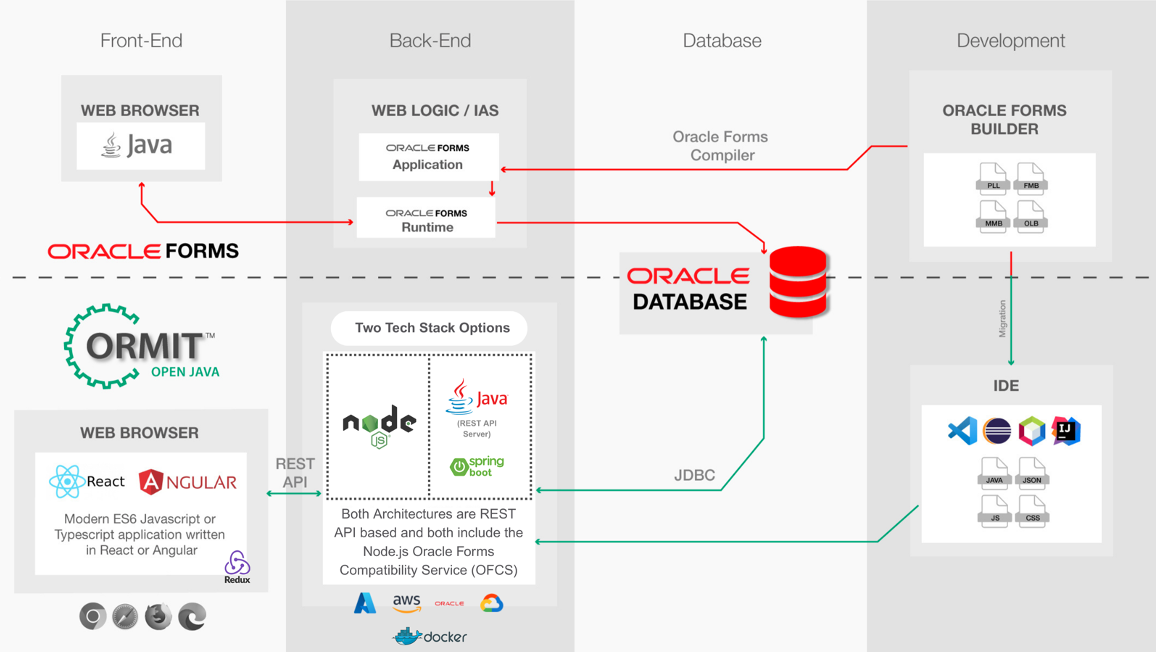
Architecture Comparison
|
COMPONENT |
JAVA + NODE.JS (DEFAULT) |
NODE.JS-ONLY |
|---|---|---|
|
UI Framework |
Angular or React |
Angular or React |
| State Management | Redux (JavaScript-based) | Redux (JavaScript-based) |
| Back-End Language | JavaScript or TypeScript | JavaScript or TypeScript |
| REST API Server | Java (Spring Boot) + Node.js | 100% Node.js |
| Container | Docker (with embedded Tomcat) |
Docker or Node-native |
| App Server Compatibility | Tomcat, JBoss, or equivalent | Node.js |
| Oracle Forms Compatibility (OFCS) | Node.js (backend-only) | Node.js |
Frontend Options: React vs. Angular
| Aspect | React (Default) | Angular |
|---|---|---|
| Architecture | Library focused on UI rendering | Full-featured framework with batteries included |
| Learning Curve | Lower, but needs 3rd-party libs | Steeper, includes routing, DI, forms |
| Flexibility | Highly customizable | Opinionated structure for large apps |
| Community & Support | Widely adopted, large ecosystem | Strong enterprise support |
| Integration | Easy with existing apps | Great for greenfield apps with structure |
Mapping Oracle Forms to Modern Components
ORMIT™-OpenJava seamlessly translates Forms components into modern equivalents:
| Oracle Forms | ORMIT™-OJ React Front End | ORMIT™-OJ Angular Front End |
|---|---|---|
| Absolute positioning | CSS Grid + Flex positioning | CSS Grid + Flex positioning |
| Direct fields Styling |
CSS + Material UI (MUI) themes |
CSS + Material UI (MUI) themes |
| Canvas | React Components | Angular Components |
| Canvas section | React Zone | Angular Zone Component |
| Item | State Data Slices | State Data Slices |
| Item Field Type | MUI React Components | Angular MUI Components |
| Properties | State Data Slices | State Data Slices |
| Menu | MUI Menus | MUI Menus |
| PL-SQL | JavaScript | TypeScript |
| Database based access control | Authorization header + API Accesses | Authorization header + API Accesses |
| Database Table | Redux Slice | Redux Slice |
| Built-ins | Global Redux Thunks, Included library | Global Redux Thunks, Included library |
| PLL Library | Global or Form scope Redux Thunks | Global or Form scope Redux Thunks |
| Form parameters | Redux Slice | Redux Slice |
| Window | React Component (page/dialog) | Angular Component (page/dialog) |
| Multi-Record Block | MUI Grid | Angular AG Grid |
| Single Record Block | Model + Store + Data Slice |
Model + Store + Data Slice |
| Alerts | React Component + Data Slice | Angular Component + Data Slice |
| Triggers | JavaScript Thunk | JavaScript Thunk |
Beyond Forms: Modernizing Reports and Databases
Oracle Reports with ORMIT™-Jasper
ORMIT™-Jasper converts Oracle Reports (RDF) into JasperReports, preserving layouts, parameters, and logic. It supports:
- REST API embedding for seamless integration.
- Multilingual output, barcodes, and scheduling.
- Open-source Jasper Community Edition for cost savings.
Oracle Database to PostgreSQL with ORMIT™-Cortex
ORMIT™-Cortex migrates Oracle Databases to PostgreSQL, offering:
- Automatic PL/SQL to PL/pgSQL conversion.
- Comprehensive schema migration (tables, indexes, views).
- License-free, portable PostgreSQL with no proprietary hooks.
- Deployment flexibility across any cloud or on-prem.
Security, Scalability, and Performance
ORMIT™-OpenJava prioritizes enterprise-grade security and performance:
- Security: Role-based access control, secure session handling, and encryption for data at rest and in transit. Integrates with LDAP, OAuth, or SAML-based SSO.
- Scalability: Stateless REST architecture with client-side session management and connection pooling for horizontal scaling.
- Performance: Asynchronous operations, lazy loading, and smart data fetching optimize speed and responsiveness.
Customer Success Stories
Case Study: Modernizing a Manufacturing Leader’s Oracle Forms
A leading North American manufacturing company relied on over 100 Oracle Forms modules to manage supply chain operations, inventory tracking, and production scheduling. The legacy system, built on Oracle Forms 11g, faced significant challenges: high Oracle WebLogic licensing costs, a dated user interface that slowed worker productivity by 25%, and limited integration with modern supply chain APIs, hindering real-time data exchange. The shrinking pool of Oracle Forms developers further increased maintenance costs and risks.
RENAPS utilized ORMIT™-OpenJava to transform the system into a modern, cloud-native application using a React frontend and Node.js backend, preserving 99% of the original business logic. The ORMIT™ Squad Model drove the project through agile 3-week sprints, with ORMIT™-Analyzer identifying module dependencies and dead code to streamline migration. The solution’s REST API integration enabled seamless connectivity with third-party logistics platforms, while training ensured the client’s IT team could maintain the system using standard JavaScript tools.
Completed in just 5 months, the modernization eliminated Oracle licensing costs, reducing TCO by 60%. The revamped interface, optimized for desktop and tablet use, improved worker productivity and achieved an 100% user adoption rate within weeks. The system’s scalability supported a 20% increase in transaction volume without any performance degradation.
Automation Metrics Achieved
| Metric | Value |
|---|---|
| Modules Migrated | 100+ |
| Lines of Code | 200,000 |
| Automation Level | 87% |
| Manual Effort Reduction | 85% |
| Project Timeline | 5 months |
This case study highlights RENAPS’ ability to deliver rapid, high-value Oracle Forms modernization, enabling manufacturers to optimize operations and reduce costs.
Case Study: Oracle Forms Automated Migration to JavaScript/React
A leading European insurance company approached RENAPS in 2024 to modernize its legacy Oracle Forms and Reports applications, central to policy management, claims processing, and customer service. The challenges included an outdated architecture that hindered integration with modern platforms, high Oracle licensing and maintenance costs, and inefficient user interfaces that slowed claims processing by 30%. Additionally, stringent security and scalability requirements demanded a solution that could meet enterprise-grade standards without disrupting operations.
RENAPS deployed the ORMIT™ Squad Model, leveraging ORMIT™-OpenJava’s automation capabilities to streamline the transformation. The project was structured into agile sprints, with multidisciplinary squads completing 4-week cycles that included analysis, code conversion, testing, and stakeholder reviews. ORMIT™-Analyzer mapped module interdependencies, enabling prioritized migration, while 89% automation minimized manual effort, ensuring fidelity to the original business logic.
The results were remarkable: the migration, completed in 12 months, reduced operational costs by 35% by eliminating Oracle licensing fees. The modernized system improved claims processing efficiency by 40%, driven by a responsive, user-friendly interface, and achieved a 90% user adoption rate after only 3 weeks of go-live. Comprehensive documentation empowered the insurer’s IT team to manage the system independently, ensuring long-term maintainability.
“This project showcased the power of automation and agility in tackling complex legacy systems. The ORMIT™ Squad Model not only delivered a future-proof solution but also empowered our client to innovate with confidence.”
— Patrick Hamou, President at RENAPS
Automation Metrics Achieved
| Metric | Value |
|---|---|
| Modules Migrated | 300+ |
| Lines of Code | 500,000 |
| Automation Level | 90% |
| Manual Effort Reduction | 85% |
| Project Timeline |
12 months |
This case study demonstrates RENAPS’ ability to deliver large-scale Oracle Forms modernization with precision, aligning with strategic business goals while minimizing risks. Learn more about the ORMIT™ Squad Model.
Comparing Migration Approaches
| Tool | Target Stack | Lock-in | UX Approach |
Technology Generation |
Logic Conversion |
Ease of Maintainability |
|---|---|---|---|---|---|---|
|
VisionX |
Java (JVx/Vaadin) + VisionX tooling |
High |
Proprietary low-code + applet UI |
2010s |
Limited – no PL/SQL mapping | Low – fragmented, tool-dependent |
|
Re_Forms21 |
Java + Proprietary Runtime | High | Like-for-like Forms | 2000s–2010s | ~99%, proprietary APIs |
Low – tied to framework |
| Morphis-Tech | Java or .NET (MVC) + Libraries | High | Modern web UX | 2010s |
~80–90%, optimized |
Average – standard tech |
| PITSS.CON | Oracle APEX |
High (Oracle) |
Redesigned APEX UI | 2000s–2010s | 70% in Oracle DB | High (in APEX) |
|
Ispirer |
Java (Traditional) | Medium–High |
No UI migration – back-end only |
2010s | Partial – code-only, no UI | Low–Medium – devs must refactor |
| ORMIT™-OpenJava |
React/Angular + Node.js/Spring Boot |
None |
Modern, responsive (JS/TS) |
2020s+ | ~99%, clean JS/TS | High – open & modular |
ORMIT™-OpenJava stands out for its open architecture, modern UX, and cloud readiness.
The ORMIT™ Squad Model: Your Path to Modernization Success
Modernizing Oracle Forms is a complex endeavor, but RENAPS’ ORMIT™ Squad Model ensures a low-risk, high-impact transformation. This agile delivery framework, purpose-built for Oracle Forms and Reports modernization, leverages ORMIT™-OpenJava’s automation to deliver modern, maintainable applications while aligning with your strategic goals.
Why the Squad Model?
Legacy Oracle Forms systems are deeply embedded in enterprise workflows, but their limitations—inflexible architecture, poor API integration, and scarce developer talent—hinder innovation. The ORMIT™ Squad Model addresses these challenges through:
- Automation: ORMIT™-OpenJava automates 88% of migration tasks, accelerating delivery.
- Agile Delivery: Short, predictable sprints ensure incremental value and stakeholder alignment.
- Multidisciplinary Expertise: Each squad combines technical, functional, and testing skills.
What is an ORMIT™ Squad?
' Each ORMIT™ Squad is an autonomous, agile unit focused on delivering end-to-end modernization. Squads operate in sprints, using JIRA for transparency and continuous feedback. A typical squad includes:
| Role | Description |
|---|---|
| Tech Lead |
Oversees technical consistency; expert in ORMIT™-OpenJava architecture |
| Developer(s) |
Implements migrated modules; adjusts front-end/back-end cases |
| QA Analyst(s) |
Automates testing; validates business logic and regression scenarios |
| Product Owner |
Client liaison; prioritizes backlog and defines user stories |
| Architect (Optional) |
Supports complex integrations, performance, and security |
| Scrum Master / Agile Coach |
Leads sprints; removes blockers; monitors team velocity |
Squads are supported by project directors and customer success leads, ensuring alignment with your modernization objectives.
Key Benefits of the ORMIT™ Squad Model
- Reduced Time-to-Value: Automation and agile sprints deliver faster ROI.
- Enhanced UX: Modernized applications feature responsive, user-friendly interfaces.
- Risk Mitigation: Frequent demos and collaboration minimize surprises.
- Knowledge Transfer: Comprehensive documentation and training empower your team.
- Flexibility: Choose independent operation or ongoing RENAPS support.
Government Leadership in Modernization
Public sector organizations are leading the charge:
- U.S.: The Digital Services Playbook encourages legacy modernization for cost savings and security.
- Canada: The Government of Canada Cloud Services Strategy promotes digital transformation.
RENAPS has helped public sector clients modernize Oracle Forms while meeting strict compliance standards.
Empowering Your Team
RENAPS ensures long-term success through:
- Tailored Training: Hands-on sessions for your Forms team to master the new stack.
- Hypercare Support: 3 months of post-go-live assistance with 15-minute response SLAs.
- Flexible Architectures: Aligns with your team’s Java or JavaScript expertise.
Frequently Asked Questions About Oracle Forms Modernization
Below are answers to common questions about modernizing Oracle Forms, with insights from RENAPS’ expertise.
What is the cost of Oracle Forms modernization?
The cost varies based on application complexity, module count, number of lines of code and customization needs, but ORMIT™-OpenJava’s 88% automation significantly reduces expenses compared to manual rewrites. For a precise estimate, our ORMIT™-Analyzer provides a detailed cost breakdown during the initial assessment. Learn more about analysis.
How long does it take to migrate Oracle Forms to a modern stack?
Migration timelines depend on system size and complexity, typically ranging from 3 months for smaller projects (e.g., 100 modules) to 12–18 months for large-scale transformations (e.g., 800+ modules). ORMIT™-OpenJava’s automation and agile ORMIT™ Squad Model accelerate delivery while ensuring quality.
Can ORMIT™-OpenJava handle Oracle EBS customizations?
Yes, ORMIT™-OpenJava excels at modernizing custom Oracle E-Business Suite (EBS) screens, preserving business logic and integrating seamlessly with ERP processes. It decouples custom modules into modern web interfaces, reducing dependency on legacy Forms. Explore specialized use cases.
Why is Oracle APEX not ideal for complex Forms migrations?
Oracle APEX’s declarative platform struggles to replicate Forms’ complex triggers, built-ins, and stateful logic, often requiring extensive redesign and introducing vendor lock-in. ORMIT™-OpenJava offers a flexible, open-source stack that preserves logic and supports cloud-native scalability. Read why APEX falls short.
Visual Comparisons: Oracle Forms vs. ORMIT™-OpenJava
To further demonstrate the depth and quality of our modernization, the following visuals show real-world examples of how Oracle Forms artifacts are transformed using ORMIT™-OpenJava:
- Side-by-Side Comparison – A visual look at the Oracle Forms UI next to the newly modernized React/Angular front-end (“summit” application).
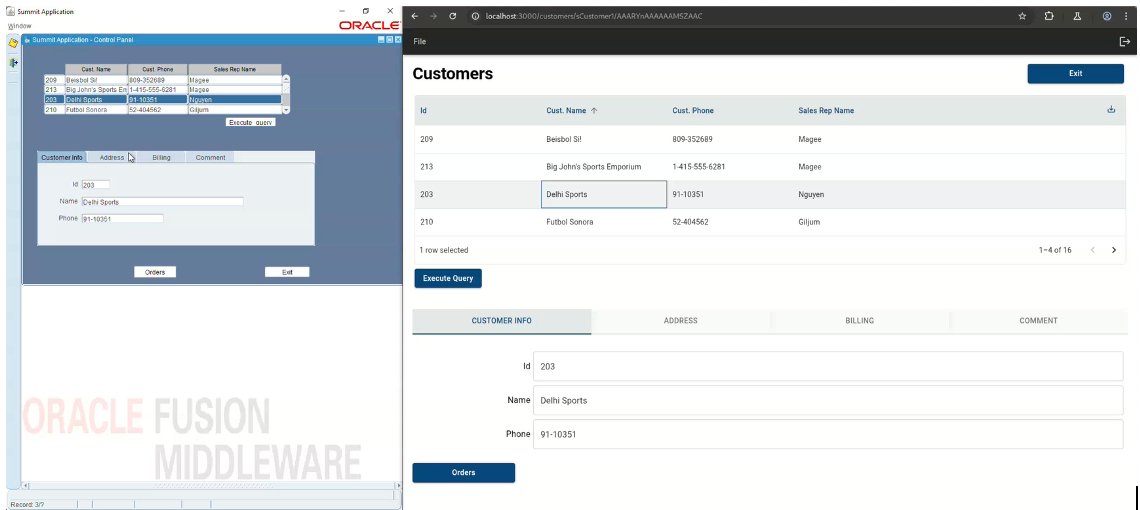
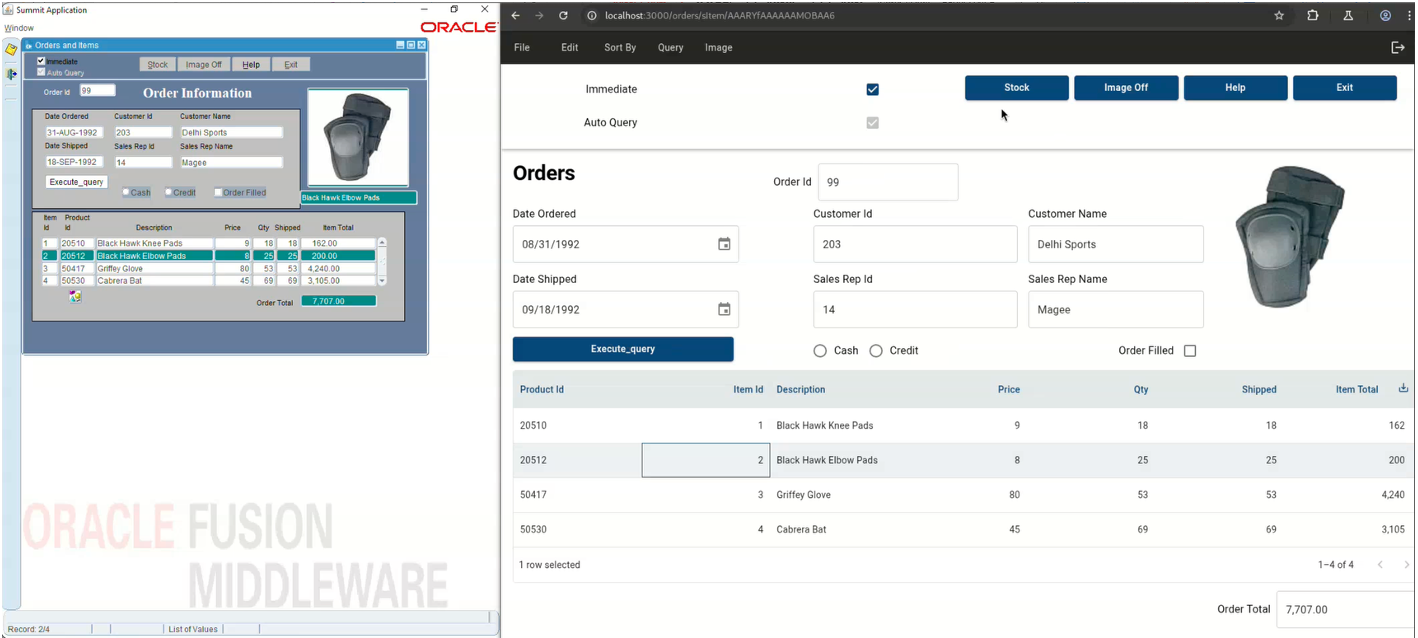
- Migrated Code Samples – Screenshots of the equivalent TypeScript or JavaScript replacing legacy PL/SQL business logic.
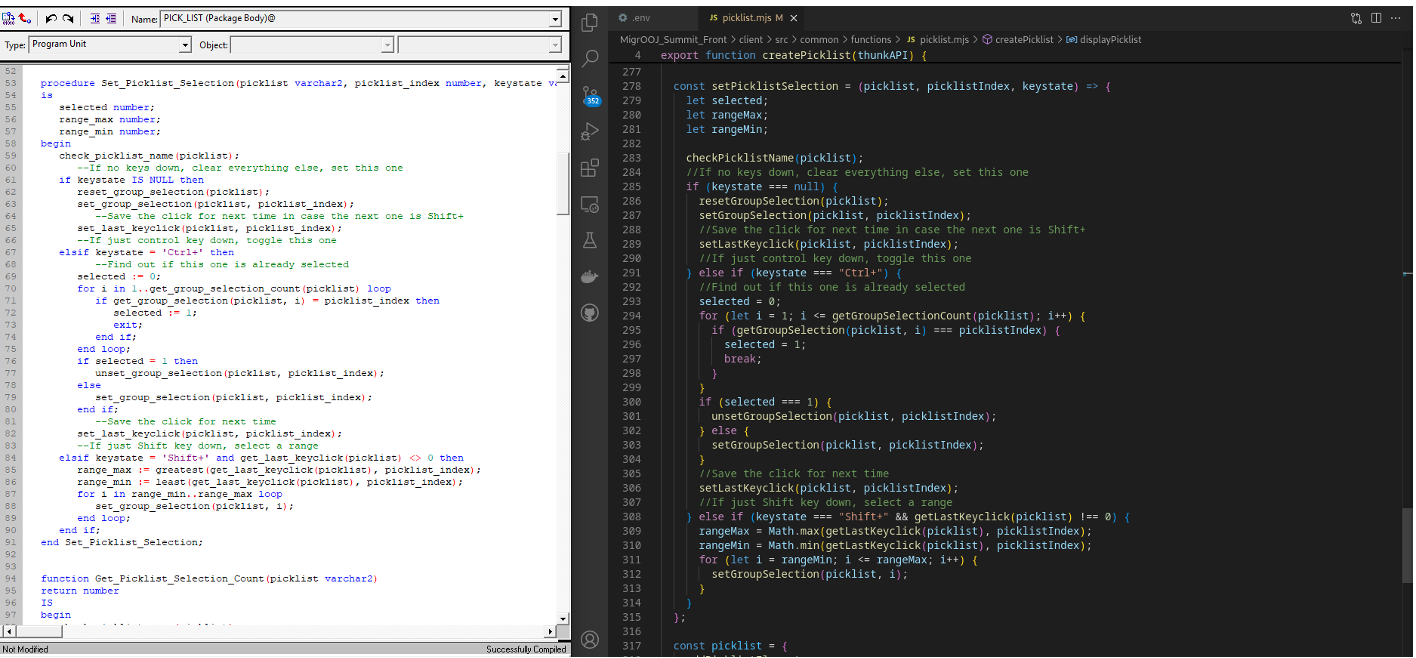
- Responsive Design Example – Demonstrates how the new UI adapts seamlessly across mobile, tablet, and desktop.
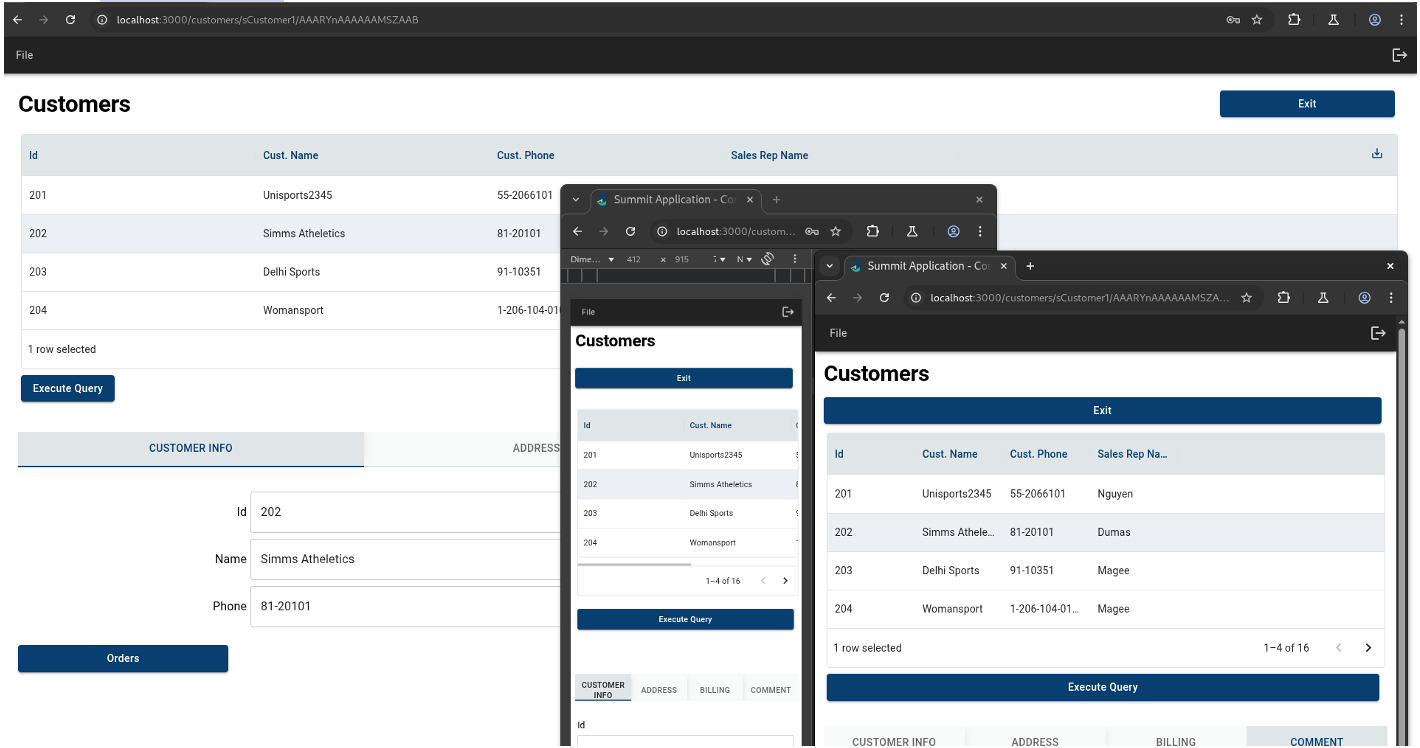
- Blocks & Items – How Oracle Forms blocks and items are restructured into modern components and state-managed slices.
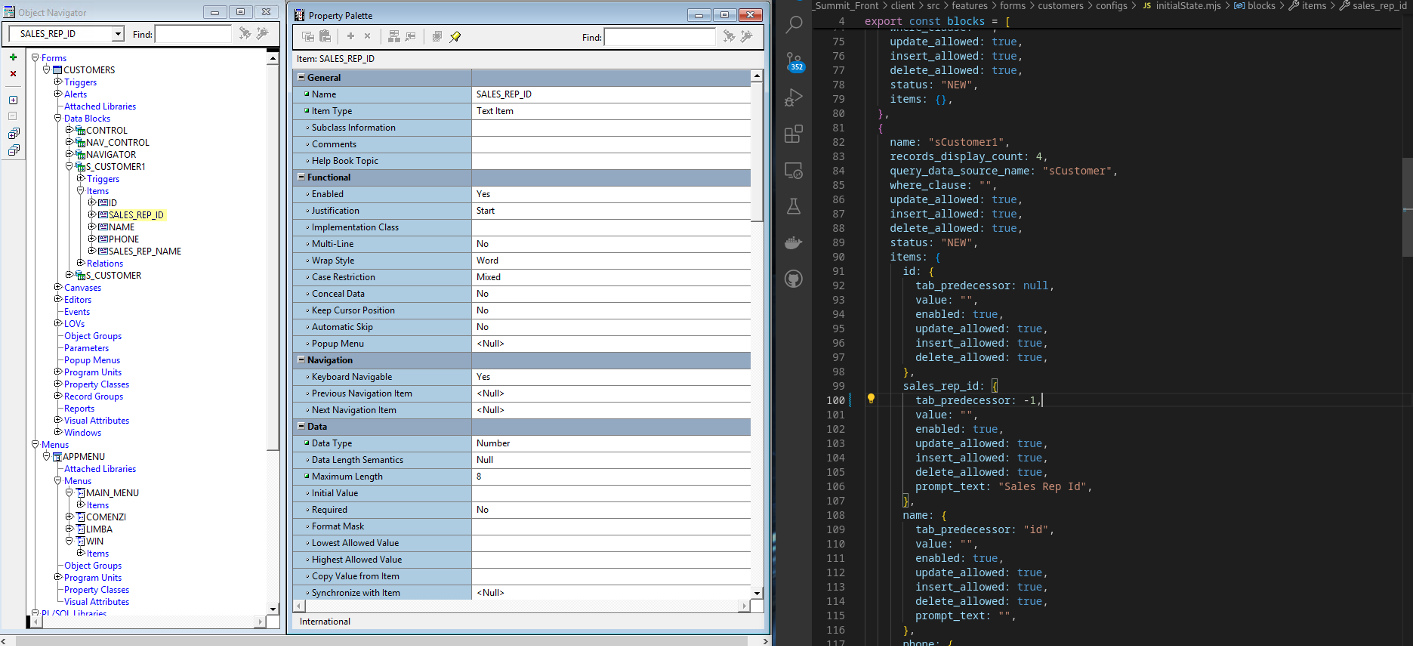
- Triggers – A look at how triggers are migrated and managed using JavaScript thunks or functional equivalents.
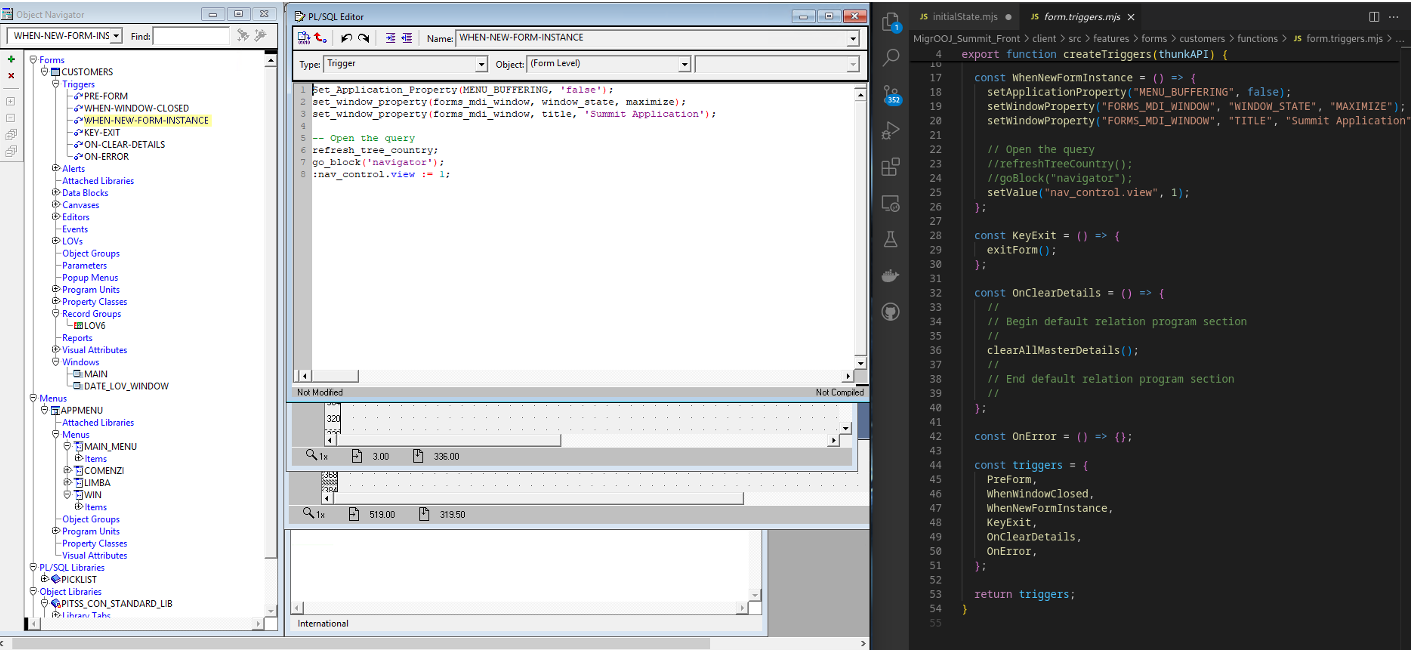
Ready to Modernize with RENAPS?
Modernizing Oracle Forms is a strategic necessity to stay competitive. With ORMIT™-OpenJava and the ORMIT™ Squad Model, RENAPS offers an automated, low-risk path to cloud-native, scalable applications. Our proven expertise, flexible architectures, and commitment to your success make us the trusted partner for Oracle Forms Modernization.
👉 Take the Next Step: Book an ORMIT™ analysis or contact us at info@renaps.com or 1-888-987-3627 to explore how RENAPS can future-proof your Oracle applications.
Further Reading:
- Why Oracle Forms Migration Projects Are So Popular in 2024
- Upgrade Oracle Forms and Reports with APEX: The Facts
References:
- The Quest for the Last Oracle Forms Developer, 2024
- Gartner, What is Legacy Application Modernization?, 2024
- Forrester Total Economic Impact Studies, 2024
- IDC Future of Digital Infrastructure Report, 2024
- McKinsey Digital Modernization Insights, 2024
- Red Hat’s 2023 State of Enterprise Open Source
Summary Table of Links
| Item | Type | URL | Source |
|---|---|---|---|
| Why Oracle Forms Migration Projects Are So Popular in 2024 | Further Reading | RENAPS | |
| Upgrade Oracle Forms and Reports with APEX: The Facts | Further Reading |
https://www.renaps.com/en/blog/Upgrade-Oracle-Forms-and-Reports-using-APEX |
RENAPS |
|
The Quest for the Last Oracle Forms Developer, 2024 |
Reference | Medium | |
| Gartner, What is Legacy Application Modernization?, 2024 | Reference | https://www.gartner.com/en/topics/legacy-application-modernization | Gartner |
|
Forrester Total Economic Impact Studies, 2024 |
Reference | Forrester | |
|
IDC Future of Digital Infrastructure Report, 2024 |
Reference | IDC | |
|
McKinsey Digital Modernization Insights, 2024 |
Reference | https://www.mckinsey.com/capabilities/mckinsey-digital/our-insights | Mckinsey |
|
Red Hat’s 2023 State of Enterprise Open Source |
Reference |
https://www.redhat.com/en/enterprise-open-source-report/2023 |
Redhat |
Posted by Sandra Hamou on 2025:05:14 17:17:04